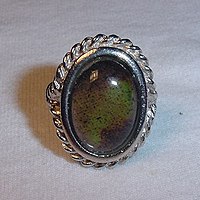Mood ring: Difference between revisions
m Reverted 1 edit by 68.215.213.222 identified as vandalism to last revision by Tagishsimon. (TW) |
No edit summary |
||
| Line 8: | Line 8: | ||
==Function== |
==Function== |
||
A mood ring is a specialized [[liquid crystal thermometer]], wearable on the finger. The ring is typically ornamented with a [[faux]] [[gemstone]] (usually made of [[quartz]] or [[glass]]) which is either a clear capsule filled with [[thermochromic]] [[liquid crystal]], or has a thin sheet of liquid crystal sealed underneath. Changes in temperature cause the crystal to reflect different wavelengths of light which changes the color of the stone. The liquid crystal used in mood rings is usually set up to display a "neutral" color at the average human skin temperature, which is approximately |
A mood ring is a specialized [[liquid crystal thermometer]], wearable on the finger. The ring is typically ornamented with a [[faux]] [[gemstone]] (usually made of [[quartz]] or [[glass]]) which is either a clear capsule filled with [[thermochromic]] [[liquid crystal]], or has a thin sheet of liquid crystal sealed underneath. Changes in temperature cause the crystal to reflect different wavelengths of light which changes the color of the stone. The liquid crystal used in mood rings is usually set up to display a "neutral" color at the average human skin temperature, which is approximately 98.6[[Fahrenheit|°F]] (36[[Celsius|°C]]).<ref>[http://hypertextbook.com/facts/2001/AbantyFarzana.shtml Temperature of a Healthy Human (Skin Temperature)<!-- Bot generated title -->]</ref> |
||
The theory behind the idea that the ring indicates the wearers' mood is based on a claim that [[body heat]] fluctuates with the emotional state of the wearer. Human body temperatures are known to vary by small amounts (less than 1°C) over the [[Thermoregulation#Normal_human_temperature|circadian and menstrual cycles]] and when the body is fighting an infection. Variations in ambient air temperature appear to have a larger effect on the temperature of the ring than changes in the body temperature of the wearer.{{Fact|date=May 2008}} It appears that no direct correspondence between a particular mood and a specific color has ever been substantiated. |
The theory behind the idea that the ring indicates the wearers' mood is based on a claim that [[body heat]] fluctuates with the emotional state of the wearer. Human body temperatures are known to vary by small amounts (less than 1°C) over the [[Thermoregulation#Normal_human_temperature|circadian and menstrual cycles]] and when the body is fighting an infection. Variations in ambient air temperature appear to have a larger effect on the temperature of the ring than changes in the body temperature of the wearer.{{Fact|date=May 2008}} It appears that no direct correspondence between a particular mood and a specific color has ever been substantiated. |
||
Revision as of 03:48, 20 June 2009
This article needs additional citations for verification. (July 2008) |

A mood ring is a ring which contains a thermochromic element, such as liquid crystal. The ring changes color in response to the body temperature of its wearer. The color is said, by some proponents, to indicate the emotional state of the wearer.
History
The mood ring was invented in the late 1960s by Marvin Wernick[1] [2] when he accompanied a doctor friend to a nearby emergency. When the doctor pulled out a strip of thermotropic material to gauge the child's temperature by applying the strip directly to his forehead, jewelry designer Wernick knew he had the makings of a winning item. Wernick encapsulated ovals of the material within clear glass cameos and glass domes set in brushed gold and silver ring settings. His signature "hang-tag" contained claims for the ring's properties.
Function
A mood ring is a specialized liquid crystal thermometer, wearable on the finger. The ring is typically ornamented with a faux gemstone (usually made of quartz or glass) which is either a clear capsule filled with thermochromic liquid crystal, or has a thin sheet of liquid crystal sealed underneath. Changes in temperature cause the crystal to reflect different wavelengths of light which changes the color of the stone. The liquid crystal used in mood rings is usually set up to display a "neutral" color at the average human skin temperature, which is approximately 98.6°F (36°C).[3]
The theory behind the idea that the ring indicates the wearers' mood is based on a claim that body heat fluctuates with the emotional state of the wearer. Human body temperatures are known to vary by small amounts (less than 1°C) over the circadian and menstrual cycles and when the body is fighting an infection. Variations in ambient air temperature appear to have a larger effect on the temperature of the ring than changes in the body temperature of the wearer.[citation needed] It appears that no direct correspondence between a particular mood and a specific color has ever been substantiated.
References
- ^ Shook, R: "Why Didn't I Think of That!", page 39. The New American Library, 1982. ISBN 0-453-00419-9
- ^ "Mood Ring Colors Chart". Retrieved 2009-01-05.
- ^ Temperature of a Healthy Human (Skin Temperature)
